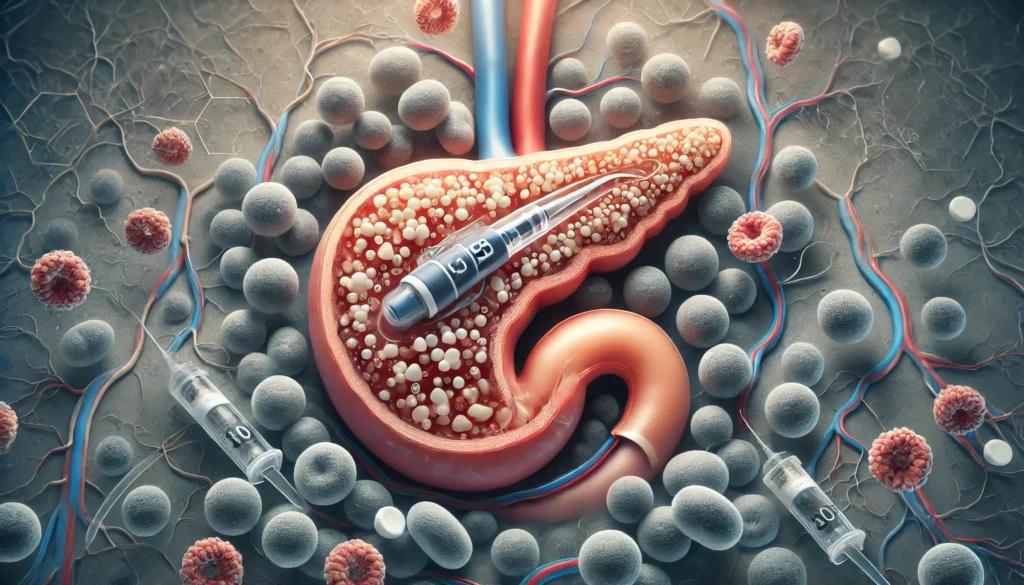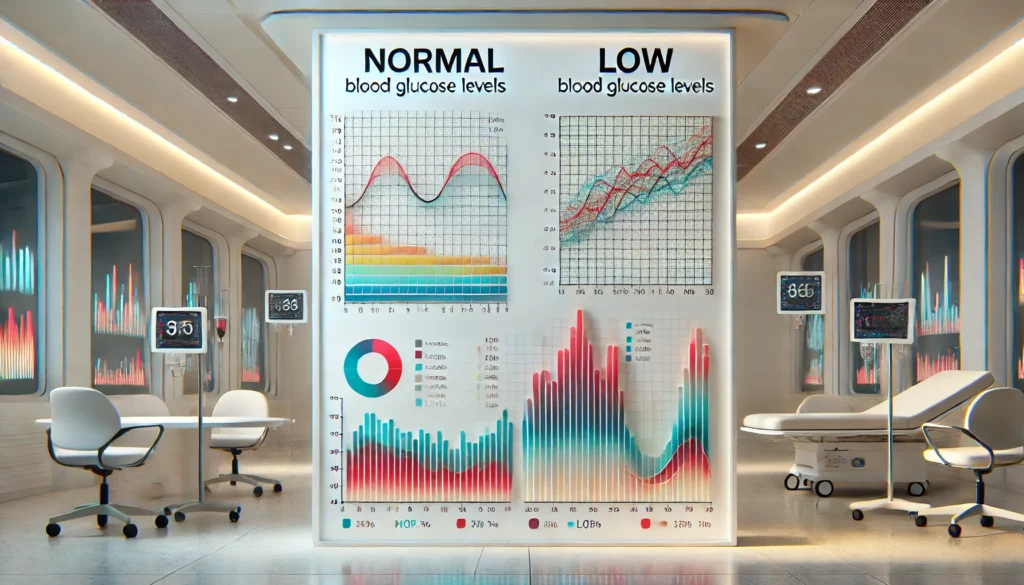Introduction: The Importance of Understanding Low Blood Sugar
Low blood sugar, also known as hypoglycemia, is a condition that occurs when blood glucose levels drop below normal ranges, leading to a variety of physiological and cognitive symptoms. Understanding the causes, effects, and management strategies for hypoglycemia is crucial for individuals with diabetes, healthcare professionals, and even those without diabetes who may experience occasional dips in blood sugar levels. This comprehensive guide explores the science behind hypoglycemia, provides a medically accurate low blood glucose levels chart, and delves into best practices for prevention and treatment.
You may also like: How Diabetes Affects the Brain: Understanding Brain Fog, Memory Loss, and Mental Confusion from High Blood Sugar
Blood glucose is the primary source of energy for the body, particularly for the brain, which relies on a steady supply of glucose to function properly. When blood sugar levels fall too low, the body triggers hormonal responses designed to restore glucose balance, but if left untreated, hypoglycemia can lead to severe health complications, including seizures, loss of consciousness, and even coma. By equipping yourself with the knowledge of how to identify, manage, and prevent low blood sugar episodes, you can ensure optimal health and reduce the risks associated with this condition.
This article will provide a detailed breakdown of the physiological mechanisms behind hypoglycemia, the common symptoms and risk factors, and evidence-based treatment options. Additionally, it will offer a scientifically validated low blood sugar range chart to help readers understand what constitutes a hypoglycemic episode and how to respond effectively.

The Science Behind Blood Sugar Regulation
The body maintains blood glucose levels within a narrow range through a finely tuned system involving hormones such as insulin and glucagon, as well as other regulatory mechanisms. Insulin, secreted by the pancreas, facilitates the uptake of glucose into cells, lowering blood sugar levels. Conversely, glucagon stimulates the liver to release stored glucose when levels drop too low. This balance is critical for maintaining stable energy levels and ensuring the proper function of organs, particularly the brain.
When an individual consumes carbohydrates, the digestive system breaks them down into glucose, which is then absorbed into the bloodstream. In response, the pancreas releases insulin to promote glucose uptake into cells for energy production. However, if too much insulin is present or if glucose consumption is insufficient, blood sugar levels may drop excessively, resulting in hypoglycemia. The body’s counter-regulatory response involves the release of glucagon and other hormones like epinephrine and cortisol, which signal the liver to release glucose and increase blood sugar levels.
In people with diabetes, hypoglycemia often occurs as a result of excessive insulin administration, missed meals, or intense physical activity. However, non-diabetic individuals can also experience low blood sugar due to factors such as prolonged fasting, alcohol consumption, or certain medical conditions affecting glucose metabolism. Understanding these mechanisms is essential for effective management and prevention.
Identifying Low Blood Sugar: Symptoms and Warning Signs
Recognizing the symptoms of hypoglycemia is critical for timely intervention. The body responds to low blood sugar by triggering a cascade of physiological and neurological changes designed to restore glucose balance. Early symptoms often include dizziness, sweating, irritability, and shakiness, but as blood sugar levels continue to drop, more severe symptoms such as confusion, blurred vision, and loss of coordination may develop.
Common early symptoms of low blood sugar include:
- Shakiness or trembling
- Excessive sweating
- Hunger or food cravings
- Irritability or mood swings
- Heart palpitations or rapid heartbeat
If left untreated, hypoglycemia can progress to more serious neurological symptoms, such as:
- Confusion or difficulty concentrating
- Slurred speech
- Blurred vision or dizziness
- Weakness or fatigue
- Loss of consciousness or seizures in severe cases
The severity of symptoms depends on the extent and duration of hypoglycemia. Mild cases can often be corrected with quick carbohydrate intake, while severe cases may require medical intervention. Understanding these warning signs is essential for preventing complications and ensuring prompt treatment.
Low Blood Glucose Levels Chart: A Medically Accurate Guide
To provide a clearer understanding of what constitutes low blood sugar, the following chart outlines blood glucose levels and their associated symptoms:
| Blood Glucose Level (mg/dL) | Classification | Symptoms and Risks |
|---|---|---|
| 70-90 | Mild Hypoglycemia | Shakiness, hunger, mild sweating |
| 50-69 | Moderate Hypoglycemia | Increased sweating, irritability, confusion, dizziness |
| Below 50 | Severe Hypoglycemia | Loss of coordination, blurred vision, loss of consciousness, seizures |
These values provide a general guideline for identifying and categorizing hypoglycemia. However, individual thresholds may vary, and some people may experience symptoms at higher or lower levels. Monitoring blood sugar regularly and being aware of personal patterns is essential for effective management.
Causes and Risk Factors for Hypoglycemia
Hypoglycemia can be caused by various factors, ranging from medication use to lifestyle habits. In individuals with diabetes, insulin and certain oral medications are the most common causes of low blood sugar. However, even non-diabetic individuals can experience hypoglycemia under specific circumstances.
Common causes of hypoglycemia include:
- Excessive insulin or diabetes medication: Taking too much insulin or other glucose-lowering medications can result in dangerously low blood sugar levels.
- Prolonged fasting or skipping meals: Without sufficient carbohydrate intake, the body depletes its glucose stores, leading to hypoglycemia.
- Strenuous physical activity: Intense exercise increases glucose utilization, potentially leading to low blood sugar if adequate carbohydrates are not consumed.
- Alcohol consumption: Alcohol can interfere with glucose production in the liver, increasing the risk of hypoglycemia, particularly in fasting states.
- Medical conditions: Certain disorders, such as adrenal insufficiency or severe liver disease, can affect glucose metabolism and lead to hypoglycemia.
Understanding these risk factors can help individuals take proactive steps to prevent hypoglycemia and maintain stable blood sugar levels.
Strategies for Preventing and Managing Hypoglycemia
Effective management of hypoglycemia involves both preventive strategies and immediate treatment measures. Preventing low blood sugar requires careful monitoring, dietary planning, and appropriate medication adjustments.
Preventive strategies include:
- Eating balanced meals: Consuming a combination of carbohydrates, proteins, and healthy fats helps maintain steady blood sugar levels.
- Regular blood glucose monitoring: Checking blood sugar levels frequently allows for early detection and intervention.
- Adjusting medication doses: Individuals taking insulin or glucose-lowering drugs should work with their healthcare providers to optimize dosages.
- Carrying fast-acting carbohydrates: Keeping glucose tablets, fruit juice, or candy on hand can help treat hypoglycemia quickly when needed.
- Avoiding excessive alcohol intake: Moderating alcohol consumption reduces the risk of alcohol-induced hypoglycemia.
In cases of acute hypoglycemia, immediate treatment involves consuming 15-20 grams of fast-acting carbohydrates, such as fruit juice, glucose tablets, or a small candy bar, followed by rechecking blood sugar levels within 15 minutes. If symptoms persist, another dose may be necessary. In severe cases, emergency medical intervention may be required.

FAQ: Understanding and Managing Low Blood Sugar with Precision Tools and Insights
1. How can personalized trends in a low blood sugar range chart improve hypoglycemia management?
Identifying personal patterns within a low blood sugar range chart offers deeper insight than generic thresholds alone. While general values provide a baseline, real-world glucose data over time reveals how your body uniquely responds to stress, sleep, and activity. This is especially critical for individuals with reactive hypoglycemia or those managing insulin-dependent conditions, as their glucose dips might fall within “normal” ranges but still cause symptoms. A customized low blood sugar reading chart annotated with personal experiences—such as dizziness after a meal or fatigue post-exercise—can guide interventions before readings reach critical lows. Emerging tools like continuous glucose monitors (CGMs) now provide real-time tracking, empowering users to build a truly individualized chart for hypoglycemia tailored to their lifestyle and physiology.
2. What role does sleep quality play in fluctuations seen on a low blood glucose levels chart?
Sleep has a profound but often underestimated impact on glucose regulation, particularly during nighttime hours. Disturbed or insufficient sleep can trigger cortisol spikes and sympathetic nervous system activity, which in turn reduce insulin sensitivity and can cause erratic blood sugar drops. Reviewing a low blood glucose levels chart from a CGM or manual log can highlight how overnight hypoglycemia correlates with poor sleep cycles. Integrating data from sleep trackers into a low blood sugar range chart can help reveal whether dips in blood glucose are contributing to middle-of-the-night awakenings or morning fatigue. Adjustments like balanced bedtime snacks or stress-reducing routines may be reflected in improved stability on your low blood sugar reading chart over time.
3. Can stress management techniques be tracked effectively using a chart for hypoglycemia?
Yes, incorporating stress management outcomes into a chart for hypoglycemia offers a holistic view of how emotional and psychological factors affect blood glucose. Stress increases adrenaline and cortisol, which can initially raise blood sugar but subsequently lead to reactive drops, especially in those prone to hypoglycemia. Techniques such as deep breathing, mindfulness, or even low-impact exercise have measurable effects that show up as fewer or less severe dips on a low blood glucose levels chart. Logging stress levels alongside glucose readings allows users to recognize triggers and evaluate which strategies effectively stabilize their glucose. This approach transforms a low blood sugar reading chart from a simple diagnostic tool into a dynamic self-care guide.
4. How do dietary timing and macronutrient balance reflect on a low blood sugar reading chart?
Timing and content of meals significantly affect blood glucose regulation and are directly visible on a low blood sugar reading chart. Skipping meals, consuming high-glycemic foods alone, or eating carbohydrate-heavy snacks without protein or fat can all lead to rapid spikes followed by sharp drops. By charting glucose responses to specific meals, individuals can identify which eating patterns result in undesirable troughs on a low blood sugar range chart. For instance, pairing complex carbs with healthy fats and proteins often produces a more stable line on a chart for hypoglycemia, minimizing dangerous drops. Over time, this feedback loop helps individuals fine-tune their diets for optimal blood sugar balance.
5. Are there hormonal influences that impact trends on a low blood sugar range chart for women?
Absolutely. Hormonal fluctuations across the menstrual cycle can significantly impact glucose sensitivity and stability, particularly in women with insulin resistance or diabetes. During the luteal phase, for example, progesterone may reduce insulin efficiency, making hypoglycemic episodes more likely despite consistent eating patterns. Mapping these patterns on a low blood glucose levels chart over several cycles can uncover correlations between hormonal phases and blood sugar volatility. This empowers women to anticipate dips and proactively adjust their routines. Including menstrual data in a chart for hypoglycemia or low blood sugar reading chart facilitates precision management tailored to individual hormonal rhythms.
6. How can a low blood glucose levels chart be used to assess the effectiveness of exercise routines?
Exercise can both lower and stabilize glucose levels, but its effects vary based on duration, intensity, and individual physiology. By using a low blood glucose levels chart in conjunction with an activity log, individuals can assess whether their workouts are causing post-exercise hypoglycemia or contributing to better long-term control. For instance, resistance training may promote more stable patterns on a low blood sugar range chart, while high-intensity cardio could lead to reactive dips. Monitoring these effects using a chart for hypoglycemia helps refine workout choices for optimal metabolic balance. This data-driven approach ensures physical activity enhances rather than destabilizes blood glucose.
7. What is the long-term value of maintaining a low blood sugar reading chart for at-risk populations?
For at-risk individuals—such as those with a family history of diabetes, metabolic syndrome, or previous gestational diabetes—maintaining a low blood sugar reading chart provides early warning signals. These charts can reveal patterns of borderline hypoglycemia that might precede larger glucose regulatory issues. Longitudinal tracking helps in identifying whether these episodes are increasing in frequency or severity, enabling early intervention. Additionally, a historical low blood sugar range chart provides healthcare providers with context for preventative care, such as suggesting dietary adjustments or proactive monitoring. Over time, the chart serves not just as a reflection of past data, but as a predictive tool to safeguard metabolic health.
8. How can parents use a chart for hypoglycemia to better manage children’s dietary needs?
Children, especially those with Type 1 diabetes or congenital metabolic disorders, can experience rapid fluctuations in glucose levels. A chart for hypoglycemia tailored for pediatric patterns can help parents track blood sugar in response to school schedules, physical activity, or unplanned food intake. When used consistently, a low blood glucose levels chart reveals how seemingly minor lifestyle shifts can trigger significant episodes. This tool becomes especially valuable during transitions—such as starting school or entering puberty—when physiological and behavioral changes impact glucose needs. By integrating behavioral notes into a low blood sugar reading chart, caregivers can fine-tune routines that support stable energy and mood.
9. Are there emerging technologies that enhance the accuracy of a low blood sugar range chart?
Yes, technology is transforming how we collect and interpret data in a low blood sugar range chart. Wearable biosensors now deliver near-real-time glucose readings, minimizing user error and increasing frequency of data points. AI-powered apps can interpret patterns on a low blood sugar reading chart, offering personalized alerts or even predicting future episodes based on prior data. Some platforms even allow integration of food, mood, sleep, and medication logs into a unified chart for hypoglycemia, providing a holistic health snapshot. These innovations are particularly valuable for individuals seeking tighter glucose control without constant manual input. As these tools become more accessible, they will revolutionize the utility and precision of the traditional low blood glucose levels chart.
10. What psychological impacts can prolonged monitoring via a low blood glucose levels chart have, and how can they be mitigated?
Constant monitoring, especially for those with anxiety-prone personalities, can lead to stress or even obsessive behaviors around glucose data. Viewing every dip on a low blood glucose levels chart as a crisis may result in unnecessary interventions or dietary overcorrections. To avoid this, it’s important to frame the low blood sugar range chart as a guide—not a judgment—and interpret trends over time rather than reacting to isolated values. Working with a healthcare provider or counselor can help set healthy boundaries and establish confidence in your body’s resilience. Integrating positive feedback—like noting improvements on your chart for hypoglycemia after self-care efforts—can reinforce a sense of control and reduce emotional strain associated with ongoing tracking.

Conclusion: Staying Proactive About Blood Sugar Health
Understanding hypoglycemia is essential for maintaining overall health and preventing serious complications. By recognizing the symptoms, utilizing a medically accurate low blood glucose levels chart, and implementing evidence-based management strategies, individuals can effectively prevent and treat low blood sugar episodes. Whether you have diabetes or simply experience occasional drops in blood sugar, staying informed and proactive is key to maintaining stable glucose levels and ensuring optimal well-being.
low blood sugar symptoms, managing hypoglycemia, blood glucose regulation, causes of low blood sugar, hypoglycemia treatment, diabetic blood sugar levels, glucose monitoring tips, insulin and blood sugar, hypoglycemia prevention, blood sugar control strategies, low blood sugar complications, emergency hypoglycemia treatment, best foods for low blood sugar, glucose levels in diabetes, alcohol and blood sugar, exercise and glucose balance, fasting and blood sugar drops, hypoglycemia in non-diabetics, maintaining healthy glucose levels, understanding blood sugar fluctuations
Further Reading:
Low Blood Glucose (Hypoglycemia)
Your guide to understanding Hypoglycemia (low blood sugar)
Disclaimer: The content published on Better Nutrition News (https://betternutritionnews.com) is for informational and educational purposes only. It is not intended as a substitute for professional medical advice, diagnosis, or treatment. Always seek the guidance of a qualified healthcare professional before making any changes to your diet, nutrition, or wellness practices. The opinions expressed by authors and contributors are their own and do not necessarily reflect those of Better Nutrition News.
Better Nutrition News and its affiliates make no representations or warranties regarding the accuracy, completeness, or reliability of the information provided. We disclaim all liability for any loss, injury, or damage resulting from the use or reliance on the content published on this site. External links are provided for reference purposes only and do not imply endorsement.



